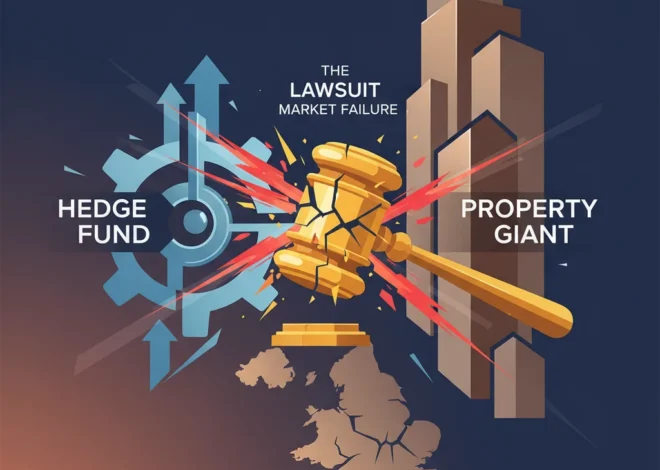
The Canary in the Coal Mine? Why MicroStrategy’s Plunge is a Bigger Signal Than Bitcoin’s Stumble
In the volatile world of digital assets, price swings are the norm. But recently, the market witnessed a tremor that sent ripples far beyond the usual chatter. Bitcoin, the undisputed king of cryptocurrencies, took a notable tumble from its lofty heights. Yet, something far more dramatic was happening in the traditional stock market. MicroStrategy (MSTR), the software company turned de facto Bitcoin holding corporation, didn’t just stumble—it plummeted, falling significantly faster and harder than the asset it has staked its entire future on.
This divergence isn’t just a statistical anomaly; it’s a critical signal for anyone involved in investing, finance, or the burgeoning world of financial technology. It forces us to ask a pivotal question: Is this merely a temporary correction in a high-beta stock, or is MicroStrategy’s exaggerated slide the canary in the coal mine, signaling a deeper shift in investor sentiment and risk appetite? This article delves into the mechanics behind MicroStrategy’s high-stakes gambit, the macroeconomic forces at play, and what this episode reveals about the future of corporate treasury strategy and the wider economy.
A Tale of Two Tumbles: Unpacking the Leverage Effect
To understand the significance of the recent market action, we must first look at the numbers. While Bitcoin experienced a pullback from around $72,000 to the $65,000 level, a drop of approximately 9-10%, MicroStrategy’s stock price experienced a much more severe decline in the same period. This disparity is not accidental; it is the direct result of the company’s aggressive, debt-fueled acquisition strategy. MicroStrategy acts as a leveraged play on Bitcoin, designed to amplify returns—but as investors are now keenly aware, leverage is a double-edged sword that magnifies losses with equal, if not greater, ferocity.
Let’s visualize the difference in performance to see this leverage in action.
| Asset | Approximate Peak Price (Recent) | Approximate Trough Price (Recent) | Percentage Decline |
|---|---|---|---|
| Bitcoin (BTC) | ~$72,000 | ~$65,000 | ~9.7% |
| MicroStrategy (MSTR) | ~$1,900 | ~$1,480 | ~22.1% (source) |
As the table clearly illustrates, MicroStrategy’s drop was more than double that of Bitcoin. This is the premium and the price of its strategy. Investors aren’t just buying a company that holds Bitcoin; they are buying into a company that actively borrows money to acquire more, betting that the future appreciation of Bitcoin will far outpace the cost of its debt.
The Saylor Strategy: A Masterstroke of Corporate Finance or a High-Wire Act?
At the heart of MicroStrategy’s identity is its co-founder and chairman, Michael Saylor, an evangelist for Bitcoin as the ultimate treasury reserve asset. His strategy is straightforward yet audacious: issue debt, typically in the form of convertible notes, and use the proceeds to buy Bitcoin. The company recently announced another $700 million offering of convertible notes for this very purpose, adding to its already massive holdings.
But what are convertible notes, and why are they central to this strategy? In simple terms, they are a form of short-term debt that can be converted into the company’s stock at a later date. This is an attractive form of financing for a company like MicroStrategy because it often comes with lower interest rates than traditional bonds. The downside? If the stock price rises significantly, these notes will be converted, diluting the ownership of existing shareholders. The entire model hinges on a single, crucial assumption: that Bitcoin’s price will continue its upward trajectory indefinitely and at a pace that covers interest payments and rewards shareholders for the inherent risk.
When Bitcoin is soaring, this strategy looks like genius. The company’s stock price skyrockets, driven by both the rising value of its Bitcoin holdings and the market’s enthusiasm for its aggressive accumulation. However, when Bitcoin stagnates or falls, the model’s flaws are laid bare. The debt obligations remain, interest must be paid, and the value of the underlying collateral (Bitcoin) is shrinking. This creates a pincer movement of financial pressure that explains the stock’s outsized fall. Crisis Averted: Senate Passes Funding Deal, But What Does It Mean for Your Portfolio and the Economy?
The Premium Puzzle and the Rise of ETFs
For a long time, MSTR traded at a significant premium to the actual market value of the Bitcoin it held on its balance sheet. Investors were willing to pay more for MSTR stock than for the underlying BTC for several reasons:
- Accessibility: It was an easy way to gain Bitcoin exposure through a traditional brokerage account without the complexities of crypto exchanges and digital wallets.
- Corporate Execution: Some investors bet on Michael Saylor’s ability to use corporate finance tools to acquire Bitcoin more effectively than an individual could.
- Tax Advantages: For some, holding a stock in tax-advantaged accounts like an IRA was simpler than holding cryptocurrency directly.
However, the landscape of blockchain and crypto investing has fundamentally changed with the recent approval of spot Bitcoin ETFs. These financial products now offer investors direct, low-cost exposure to Bitcoin’s price within the same traditional brokerage accounts. This development directly challenges MicroStrategy’s value proposition. Why pay a premium for a leveraged, debt-laden proxy when you can buy a direct, unleveraged equivalent for a minimal management fee? The recent price action suggests the market is beginning to re-evaluate and, perhaps, unwind that long-standing premium.
A New Pour: Can a Governance Guru Reignite Growth at Spirits Giant Diageo?
Now, with the advent of spot ETFs, that narrative is under immense pressure. The MSTR premium is no longer a given; it’s a liability in a downturn. The question for the future is whether MicroStrategy can successfully pivot its story. Can it convince the market that its leveraged strategy will still outperform in the long run, or will it be forced to behave more like a traditional holding company? Its next moves—how it manages its debt, whether it continues to issue more, and how it communicates its value proposition in an ETF world—will be a defining test for this entire model of corporate crypto adoption. This isn’t just about price; it’s about the sustainability of a pioneering, but incredibly risky, financial experiment.
The Macroeconomic Headwinds: It’s Not Just About Crypto
No asset, not even a decentralized one like Bitcoin, exists in a vacuum. The recent volatility is also deeply intertwined with the broader macroeconomic environment. The world of finance is currently fixated on the actions of central banks, particularly the U.S. Federal Reserve. For months, the market has been anticipating interest rate cuts, which typically boost the appeal of risk assets like tech stocks and cryptocurrencies by lowering the return on safer investments like bonds.
However, recent economic data has muddied the waters. Stubborn inflation and a resilient labor market have led the Fed to signal a more “higher for longer” stance on interest rates. This shift in expectations has a chilling effect on the market’s risk appetite. The prospect of sustained high interest rates makes borrowing more expensive—a direct hit to strategies like MicroStrategy’s—and increases the attractiveness of holding cash or short-term government bonds. The recent slump in Bitcoin and MSTR coincided with market repricing of these rate-cut expectations, a clear sign that traditional economics and banking policies are powerful drivers in the world of digital asset trading.
A Stumble or a Signal? Reading the Tea Leaves
So, we return to our central question: Is this a temporary stumble or a meaningful signal of what’s to come? There are compelling arguments on both sides.
The “Healthy Correction” Argument (The Stumble)
Proponents of this view argue that this is a classic bull market correction. It’s a necessary shakeout of over-leveraged traders, a consolidation phase before the next leg up. They would point to the fact that Bitcoin’s fundamental value proposition—as a hedge against inflation and a decentralized store of value—remains unchanged. In this scenario, MicroStrategy’s sharp fall is simply the expected behavior of a high-beta asset, and for those with a long-term conviction, it represents a prime buying opportunity.
The “Warning Sign” Argument (The Signal)
This more cautious perspective suggests that MicroStrategy’s plunge is a warning. It signals that the market’s tolerance for extreme leverage and narrative-driven premiums is waning, especially with the viable alternative of ETFs. Furthermore, it highlights the crypto market’s vulnerability to macroeconomic shifts. If interest rates remain high and the economy slows, the flow of capital into speculative assets could dry up, leading to a prolonged period of stagnation or decline. In this view, the MSTR premium collapse is the first domino to fall in a broader market re-evaluation of risk. Paradise Under Pressure: A Financial Deep Dive into the Tourism Sector's Economic Crisis
Conclusion: Navigating the New Reality
The dramatic divergence between Bitcoin’s stumble and MicroStrategy’s freefall is more than just a headline. It is a real-time lesson in the principles of leverage, risk, and evolving market structures. It underscores that while MSTR has been a powerful vehicle for Bitcoin exposure, it is an imperfect and high-risk one. The introduction of spot Bitcoin ETFs has permanently altered the investment landscape, forcing a re-evaluation of the premium once commanded by such proxy assets.
For investors, business leaders, and anyone interested in fintech and the future of finance, this episode offers a crucial takeaway: understanding the mechanics of an investment is just as important as believing in its underlying story. MicroStrategy’s fate is now tied not only to the price of Bitcoin but also to its ability to manage its significant debt load and justify its existence in a world where direct access to crypto is easier than ever. Whether this proves to be a stumble or a signal, one thing is certain: the relationship between the traditional stock market and the world of digital assets has just become a lot more complicated.


